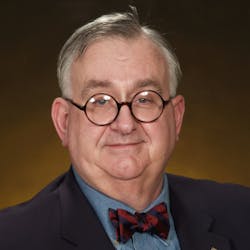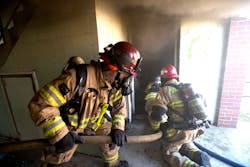Command Post: Toilet Paper and Fire Training: An Educated View
It’s my guess that many of you will find the title of this column a bit out of the ordinary. Perhaps you might wonder, “What great reflections lies amid such an odd title?” or “What spinning thought racing around in Harry’s mind brought him to select this topic?”
How is it possible, you might contemplate, to tie the topics of toilet paper and training together in any meaningful way? Actually, my friends, it is done quite easily. To begin, both are important to you and to me. Is there anyone among us who has reached this stage in life and not used the services of both of these?
Hands-on training
Do you remember the first time that you personally used toilet paper? Unless you have a photographic memory, dating to age one, I would suppose that this bit of knowledge is lost to antiquity. Let me ask you to pause and ponder the ways in which you might have come to know how to use this critical implement in the course of your daily life.
Have your skills improved with age? Is this a case of practice makes perfect? Have you ever had to complete recertification training in the use of this delicate forest product? Are you allowed to exercise personal preferences in the acquisition of this important element of daily life? Why, yes, you are. I know I have my preference.
During my many years as a government employee, I often was treated to the joy of low-bid toilet paper. Sometimes, there was “no joy in Mudville,” because the Mighty Casey of the purchasing department had struck out. Let me share with you the fact that the worst event of this type came during a trip to the United Kingdom more than four decades ago.
Some brilliant soul acquired a shipment of this critical product through the appropriate government sources, and it had the consistency of wax paper. You can imagine the problems that were presented by a product that had this texture. At that time, I suggested to my hosts, quite vocally, that more research was needed in this particular arena.
What then does this little side trip into the world of toilet paper have to do with training? Do you remember the first time that someone trained you to do something? Probably not my friends, for, you see, as a child, you almost certainly were subjected to a wide variety of training experiences in the first 18–20 years of your life. Many of them probably have blended together into a forgotten mix of memories. Although each of us have fond memories of the best teachers and trainers who we enjoyed in our life, a great many of our learning experiences are relegated to the ash heap of antiquity.
Is it the same way with your fire-training experience? Can you remember any of the fire instructors who introduced you to the world of firefighting? Instructors play a critical role in the development of new personnel in every aspect of the fire service.If you are like me, you can remember certain people and particular events. For example, for me, the year was 1966, and the place was the U.S. Firefighting School at Chanute Air Force Base in Rantoul, IL. It was my good fortune to be able to attend the resident fire protection specialist course. It was six exciting weeks of classroom and practical training that laid a solid foundation for the career that I have forged in the fire service.
When it comes to my instructors, not every name or face comes right back to me. However, there are a number among them whose impact was sufficiently great for me to keep their memories with me to this day. Let me assure you, I still carry the lessons of their training time with me to this very day.
Mr. Martin was my instructor during Block Two, where I was introduced to the hands-on side of firefighting. He taught the members of my group how to use the various tools of our trade. Perhaps the fact that I have pictures of him in my scrapbook helps to jog my memory. We all were new to the field, and he taught us in a straightforward, step-by-step method.
We were given the theory in the classroom and then allowed to exercise our limited array of knowledge under the close personal supervision of Mr. Martin. Perhaps some of you more senior troops out there were trained by Mr. Martin. Or perhaps you were trained by someone like Mr. Martin, who left his/her mark on your career.
Let me share with you that Mr. Martin’s knowing glance could tell a raw recruit whether the task in question had been completed in a proper way. We used to dread the shaking-of-the-head response, because it meant that a great deal of physical labor was going to be needed to correct our rookie mistakes.
There were two people who made Block Three, which was the crash/rescue firefighting phase, particularly interesting. Staff Sergeant Peck and Airman First Class Haney were more than instructors; they were role models. They took a group of young bucks and tempered their limited knowledge with the sage wisdom of veteran crash/rescue firefighters.
All of the instructors who I mentioned appeared to have an amazing ability to allow rookies to dance up to the edge of chaos and then bring them safely back to where they should be with a better understanding of their role in the firefighting world. Not that we ever did things in an uncontrolled or unsafe manner. No. Fire training in the U.S. Air Force was conducted under a tight set of critical controls.
Like many of you, I probably didn’t appreciate the skill and ability of those instructors at the time. How were they able to sense that we were about to screw up? How is it that they all were able to know what was around the corner and to stop us before we managed to damage ourselves?
The answer, my friends, is really quite simple. Each of these instructors possessed each of the following in ample abundance: experience; knowledge of firefighting and fire departments; knowledge of the learning process; knowledge of the teaching process; and concern for the students
It would be my guess that each of these attributes strengthened and supported the others. Perhaps we should refer to these attributes as the pentagon of pedagogical power. Each of us needs to understand how the training process works. We also need to understand that the student has a role to play within the training process.
Responsibilities
The student must arrive at the site of the learning experience ready to learn and motivated to perform. The instructor should arrive prepared to facilitate a learning experience and a sharing of knowledge. It’s at this point that the correlation between toilet paper and training comes into a proper perspective.
You play a key role in the use of each. In both cases, you’re expected to take an active part in your own destiny. There usually is immediate feedback as to the success of your performance. In neither case should you expect someone else to do the job for you.
(Members throughout the entire fire service must understand the concept of personal responsibility. It’s a concept that seems to have been lost to many in this, the 21st century.)
Every one of us must understand that opportunities exist to improve our skill set. At the very least, you can read. If your training program isn’t all that it should be, speak up. Ask for more training. Ask for better training. Ask for more outside-of-your-department training opportunities. I did that and often succeeded in moving forward.
Just because you always have done something in a particular way and manner doesn’t make that approach the “be all and end all.” Research into identifying a better way to perform a critical function shouldn’t be discouraged. People in search of knowledge shouldn’t be abused or made the subject of group ridicule.
Let me suggest that, perhaps, the philosopher, Bertrand Russell, had it right when he wrote, “In all affairs it’s a healthy thing now and then to hang a question mark on the things you have long taken for granted.” Whether you call it thinking outside of the box or give it some other name, it’s my suggestion that you do it.
Where would we be if Sir Thomas Crapper didn’t take it upon himself to alter and improve the manner in which we each find ourselves using the toilet paper that’s mentioned earlier in this missive to you? Where might we be if he didn’t question the standards and practices of his day? Is it possible that we still might be outside in that little house behind the big house, with a Sears catalog sitting on our lap?
Although many believe that Crapper invented the water closet, a closer look at history tells us that his research improved the manner in which the plumbing devices in this critical area of sanitation came together. Regardless of your view of his career, he had an impact upon civilization. The world appears to be a better place for his labors here on Earth.
Crapper’s work was an essential part of the evolutionary process in his field. It’s my suggestion that you, too, have an opportunity to contribute to the evolutionary process of your field of endeavor: fire suppression and fire protection. I urge you to try. Whether it’s in the area of toilet paper or fire training, I urge you to take an active hand in your future.
About the Author

Dr. Harry Carter
HARRY R. CARTER, Ph.D., who is a Firehouse contributing editor, is a fire protection consultant based in Adelphia, NJ. He is chairman of the Board of Commissioners in Howell Township Fire District 2 and retired from the Newark, NJ, Fire Department as a battalion commander. Carter has been a member of the Adelphia Fire Company since 1971, serving as chief in 1991. He is a life member and past president of the International Society of Fire Service Instructors and life member of the NFPA. He is the immediate past president of the U.S. branch of the Institution of Fire Engineers (IFE) of Great Britain. Carter holds a Ph.D. in organization and management from Capella University in Minneapolis, MN.
Connect with Harry:
Email: [email protected]

